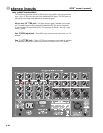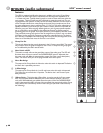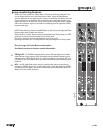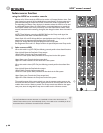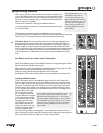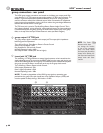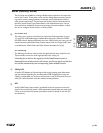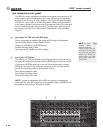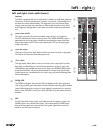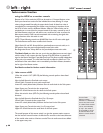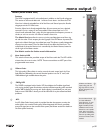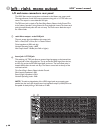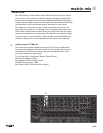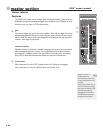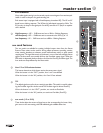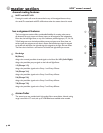
p. 35
left - right
8
left and right (main audio buses)
features
The HPW is equipped with 3 main audio buses in addition to the 8 audio subgroups.
This section of the manual deals with 2 of those 3 main buses - Left and Right, and
the Mono bus will be described later. The assignment to the L-R buses is always
through a pan-pot, either from the Mono or Stereo input channels, or from the 8
audio subgroups. Typically, these 2 main buses are used to create the overall stereo
mix.
mute switch w/LED
This switch normally will mute the post-fader output of the L or R audio bus.
The LED will illuminate when the mute is active. If the FADER REVERSE switch is
depressed, then this mute switch will affect the associated Aux output (See Fader
Reverse description). NOTE: These mute switches are NOT part of the program-
mable mute scenes.
mono bus assign
The output of the Left or Right feeds the Mono bus when this switch is depressed.
The feed to the Mono bus is post-fader, post-mute.
100mm fader
This high-quality, 100mm fader is used to control the main output level. Any Post-
fader feeds are affected by this control. Nominal position is at the “0” mark, with
10dB additional gain available above that point. When the FADER REVERSE switch
is depressed, this fader will control the associated Aux Output level, and the Main
Output level is then controlled by the Aux Level rotary pot (see the following Fader
Reverse description).
PK/Sig LED
The FADER is equipped with a bicolor LED that displays the Pre-fader signal level
with varying intensity green illumination, and also indicates impending group overload
(within 3dB of clipping) by turning red. Audio clipping is sensed both pre- and post-
fader, so even if the fader is down, you will be informed of any bus-related overload
problems.
AFL
An AFL (After-Fader Listen) switch is provided that lets the operator monitor the
FADER’s signal in the console’s Solo system. When depressed, the FADER’s post-
fader, post-mute signal sent to the console’s Solo system (See Master section for
details on the Solo system functions).
54
55
54
55
56
56
57
58
57
58



